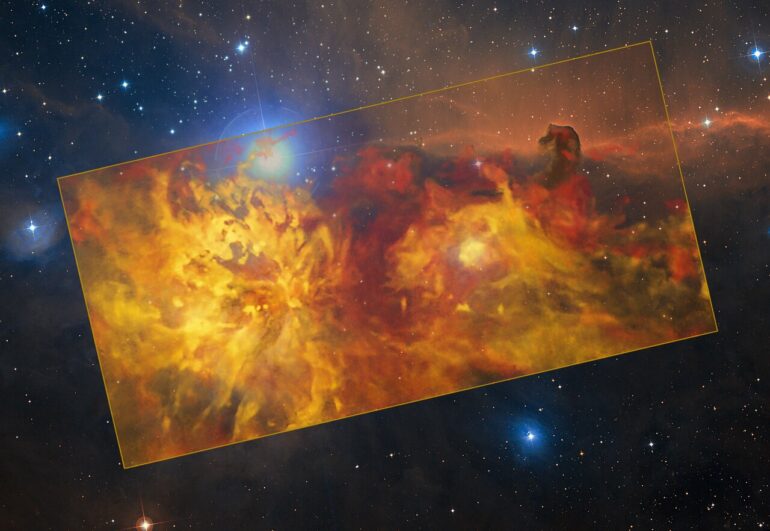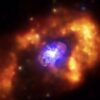Orion offers you a spectacular firework display to celebrate the holiday season and the new year with this new image from the European Southern Observatory (ESO). But no need to worry, this iconic constellation is neither exploding nor burning. The “fire” you see in this holiday postcard is Orion’s Flame Nebula and its surroundings captured in radio waves—an image that undoubtedly does justice to the nebula’s name! It was taken with the ESO-operated Atacama Pathfinder Experiment (APEX), located on the cold Chajnantor Plateau in Chile’s Atacama Desert.
The newly processed image of the Flame Nebula, in which smaller nebulae like the Horsehead Nebula also make an appearance, is based on observations conducted by former ESO astronomer Thomas Stanke and his team a few years ago. Excited to try out the then recently installed SuperCam instrument at APEX, they pointed it towards the constellation Orion. “As astronomers like to say, whenever there is a new telescope or instrument around, observe Orion: there will always be something new and interesting to discover!” says Stanke. A few years and many observations later, Stanke and his team have now had their results accepted for publication in the journal Astronomy & Astrophysics.
One of the most famous regions in the sky, Orion is home to the giant molecular clouds closest to the Sun—vast cosmic objects made up mainly of hydrogen, where new stars and planets form. These clouds are located between 1300 and 1600 light-years away and feature the most active stellar nursery in the Solar System’s neighborhood, as well as the Flame Nebula depicted in this image. This “emission” nebula harbors a cluster of young stars at its center that emit high-energy radiation, making the surrounding gasses shine.
With such an exciting target, the team were unlikely to be disappointed. In addition to the Flame Nebula and its surroundings, Stanke and his collaborators were able to admire a wide range of other spectacular objects. Some examples include the reflection nebulae Messier 78 and NGC 2071—clouds of interstellar gas and dust believed to reflect the light of nearby stars. The team even discovered one new nebula, a small object, remarkable in its almost perfectly circular appearance, which they named the Cow Nebula.
The observations were conducted as part of the APEX Large CO Heterodyne Orion Legacy Survey (ALCOHOLS), which looked at the radio waves emitted by carbon monoxide (CO) in the Orion clouds. Using this molecule to probe wide areas of the sky is the primary goal of SuperCam, as it allows astronomers to map large gas clouds that give birth to new stars. Unlike what the “fire” of this image might suggest, these clouds are actually cold, with temperatures typically just a few tens of degrees above absolute zero.
Given the many secrets it can tell, this region of the sky has been scanned many times in the past at different wavelengths, each wavelength range unveiling different, unique features of Orion’s molecular clouds. One example are the infrared observations performed with ESO’s Visible and Infrared Survey Telescope for Astronomy at the Paranal Observatory in Chile that make up the peaceful background of this image of the Flame Nebula and its surroundings. Unlike visible light, infrared waves pass through the thick clouds of interstellar dust, allowing astronomers to spot stars and other objects which would otherwise remain hidden.
More information:
Thomas Stanke et al, The APEX Large CO Heterodyne Orion Legacy Survey (ALCOHOLS). I. Survey overview, arXiv:2201.00463 [astro-ph.GA], arxiv.org/abs/2201.00463
Citation:
Orion’s fireplace: New image of the Flame Nebula (2022, January 4)



